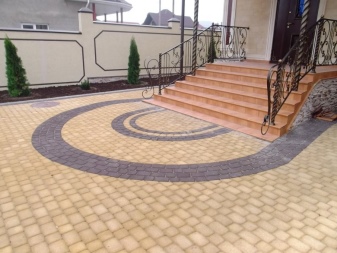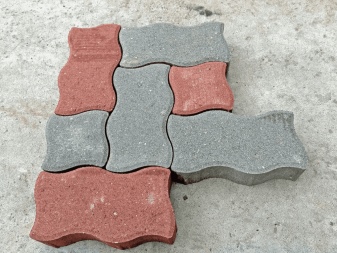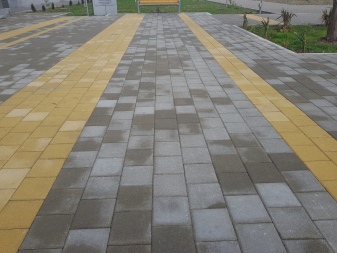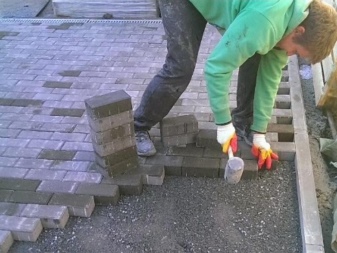All about the paving stones in the courtyard of a private house

Arrangement of the local area most often begins with the laying of paving slabs. Sometimes you can get confused in the variety of such a coating, so it is important to know which material to prefer and how to lay the elements correctly and aesthetically. The adjacent territory, lined with typesetting elements, looks neat and modern.


Peculiarities
Paving stones in the courtyard of a private house are an excellent alternative to natural stone or concrete. This practical and aesthetic material is ideal for creating beautiful garden paths that ennoble the site. If there is no experience in paving paving stones, it is better to entrust its laying to specialists. However, the correct organization of space and the arrangement of paths is possible with your own hands, according to the drawing of the site, where everything that is in the courtyard is accurately depicted. This building material is sold at an affordable price, which makes you choose it for the improvement of the site.


The use of paving stones will solve several problems at once:
- create order on the site;
- will divide the zones by functionality;
- will provide convenience and comfort when moving around the territory;
- prevent flooding of paths.


Design
The squares paved with paving stones will decorate the territory and help to create a unique landscape design on the personal plot. A photo of the design options for the territory with paving slabs will help you navigate and choose a suitable coating that meets the size of the area. On modest squares, the design looks great in small, not very catchy fragments, and large spaces are good with large tiles. A small diamond-shaped tile makes it possible to create a three-dimensional pattern on the coating.
Mosaic paving slabs will allow you to lay out a variety of artistic patterns.


Consider the main types of paving stones.
- Clover. The smooth texture, even in a light shade, remains clean in rainy weather. It is produced both in plain color and with pictures. With a complex shape of a clover petal, a combination of different colors and parameters is allowed. Two colors are most commonly used.


- Wave. The complex relief does not allow the elements to move during prolonged use and strong mechanical stress. The wave is easy to install and comes in a wide range of colors.


- Brick. It is produced with a rough or smooth texture. Suitable for heavy loads.



- English cobblestone. Imitates the texture of a natural stone of gray or brown-yellow color with an even frame. It has four corners, it can be different in texture.


- Tiles in squares or rectangular. It can be different in color and texture. A square can have a general pattern on the surface, or it is divided into parts according to texture. The alternation of multi-colored squares of various sizes looks great.


- Scales. Tiles in complex triangle format in two color options will create a 3D effect.


Laying technology
Before installing the tiles with your own hands, you have to delve into the features of the process of working with paving stones. This will prevent possible errors. First of all, you will have to create a project for the site, drawing all the buildings on the plan, and then correctly mark the location of the fence, playground, garden and other things.

Further, the following points are determined.
- Estimated load. When creating a track for moving vehicles and other overall structures, you will need strong materials that are laid on a concrete solution.
- Features of the soil. If the soil is solid, then a sand cushion will be enough for the installation of paving stones, and for soil that is inclined to move, you will have to create a more reliable foundation.
- Groundwater. In case of heavy rainfall, water can come close to the surface of the earth, which negatively affects the paths. Knowing where the groundwater lies, it will be possible to properly lay the tiles using waterproofing.
- Finance. If there are not enough funds, it is worth abandoning the plan or saving up money and postponing the venture until more favorable times. Cheap products show poor quality.
- Terrain relief. If the area cannot be leveled, the paving stones will have to be laid on concrete. Otherwise, the finished canvas on the moving ground will deform, and the appearance of the track will be spoiled.
- Climatic conditions. If there is heavy rainfall and sharp temperature fluctuations on the site, the tiles may lose their visual appeal. The choice of material and method of fastening is necessary taking into account the climatic zone.
- Landscaping. The material can complement the composition or create a special decor. To implement intricate drawings, you will need a competent drawing, sufficient experience and professional skills.



It is also important to determine the amount of materials required, taking into account the area that is supposed to be laid out with paving stones.
Here are some paving options.
- Sand pillow. A simple option that does not require large financial resources. But it is suitable only with the correct terrain and reliable soil. This base is not for heavy loads, moreover, the sand is gradually washed out by sediments.


- On a cement-sand mixture (hartsovka). Allows you to create a reliable canvas that does not deform under loads.


- Laying for screenings. Not suitable for "floating" soils, but it is easy to fit and gives a slight shrinkage.


- Creation of a concrete base. Such tracks are capable of withstanding intense loads, but the work performed is more expensive.


- Laying on asphalt. An option that is likely in the absence of deformation, otherwise the repair of the asphalt pavement entails additional costs.

After choosing the tile and preparing the base for it, you can start laying:
- installation of elements is recommended to be carried out from oneself and diagonally with a gap of 1-2 mm;
- a wooden mallet is used for installation;
- if the element falls below a predetermined level, it is removed and sand is additionally poured under it;
- a grinder with a diamond disc is used for cutting tiles;
- after installation, the surface is sprinkled with a dry mixture of sand and cement, evenly filling the seams;
- using a sprayer, water the laid out tiles;
- you can use the coating after 2 days.





Care Tips
There is a misconception that paving stones should be taken care of only as the coating becomes clogged. This approach has a detrimental effect on the appearance and quality of the paving stones. It is periodically necessary to clean the coating with special tools and specialized means. Proper care of the laid paving slabs is a guarantee of the durability of the coating. If it is not possible to regularly care for the paving stones, it is worth stopping at a not too flashy color of the coating.
The optimal interval between complex care is six months. This will extend the life of the paving stone and renew its appearance.
It is best to clean the flooring in the spring, thoroughly wash all joints and the tiles themselves.

Let's consider some types of cleaning.
- Mechanical. Suitable for the winter season, when it is necessary to get rid of ice, remove snow and debris adhering to paving stones. Here you need to have experience and dexterity, as excessive zeal can ruin the surface.
- Chemical. A number of chemicals can be used to make the coating shine in the sun.
- Wet / dry. It involves the use of polymer brushes and periodic washing. It is not necessary to wash the tiles under a strong pressure of water in order to prevent cracking and deformation of the paving stones in the future. You also need to sand the tiled joints as necessary and replace the damaged elements. If the paving slabs are located near the pool, it is advisable to treat them with a water-repellent agent.



In addition, it is important to control the loads that fall on the paving stones.
Beautiful examples in landscape design
Combining elements of different types, you can get a unique ornament on the site. Monochrome styling will ennoble the territory, and multicolor will bring brightness and originality to it. The palette is varied, yellow, gray and shades of brown are especially popular. The main thing is to combine tiles in shape and color. The texture may vary, but the thickness of the fragments must be equal.


Now let's see some interesting photo examples.
Very aesthetic tiles of a round shape, complete with octagonal shapes with semicircular cutouts.

The marvelous configuration of "chamomile" allows for intricate compositions.

Octagonal tiles look exquisite in combination with smaller square details.

Spontaneous styling is interesting when using elements of different colors.

The herringbone design looks harmoniously with elements of different tones. This design option allows you to visually enlarge the area.

A zigzag is the easiest way to refine your garden paths.














The comment was sent successfully.